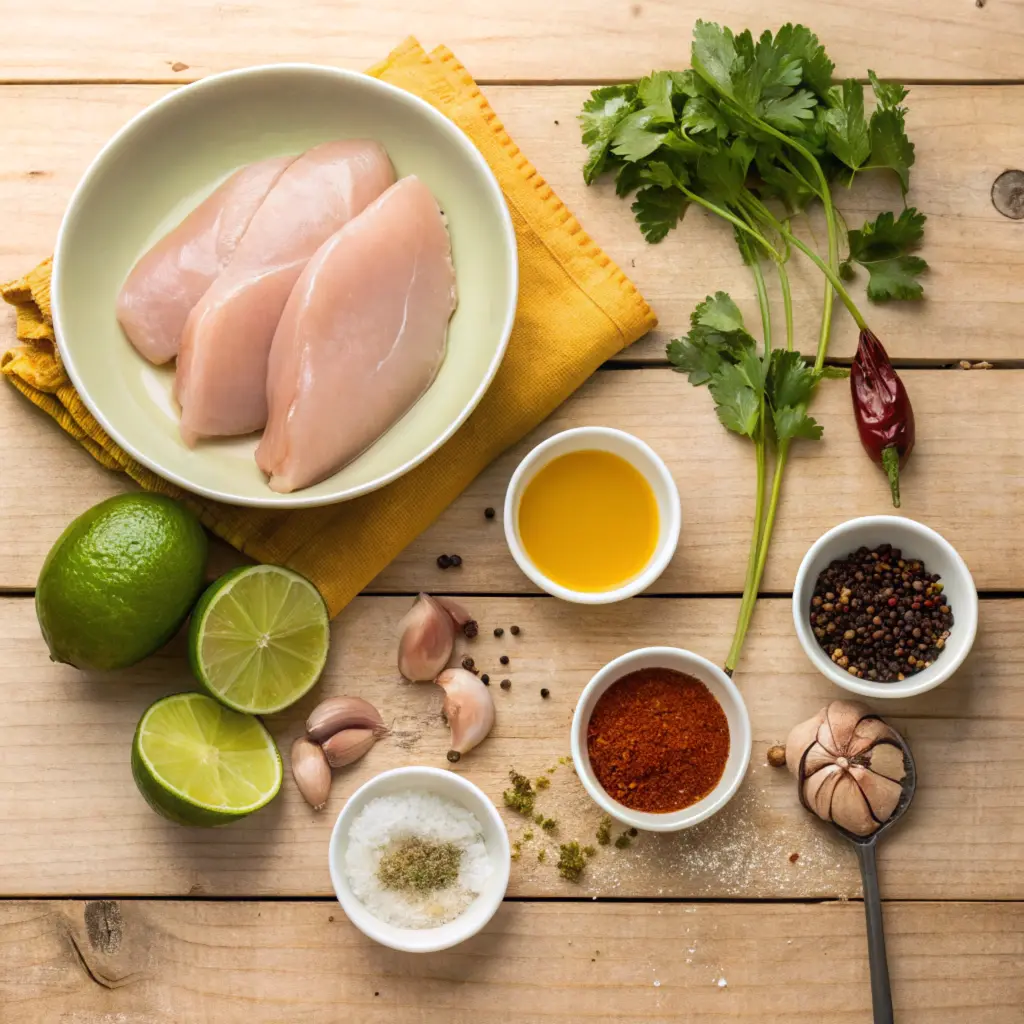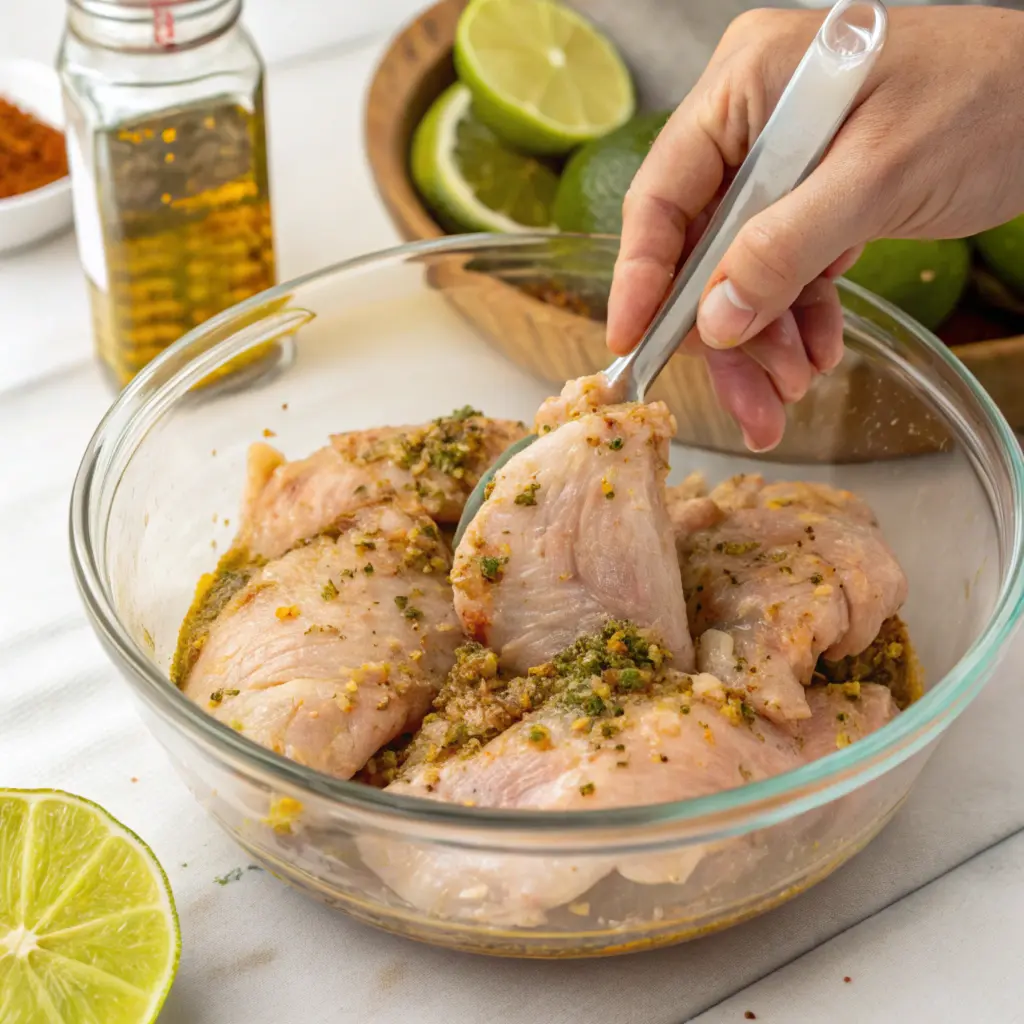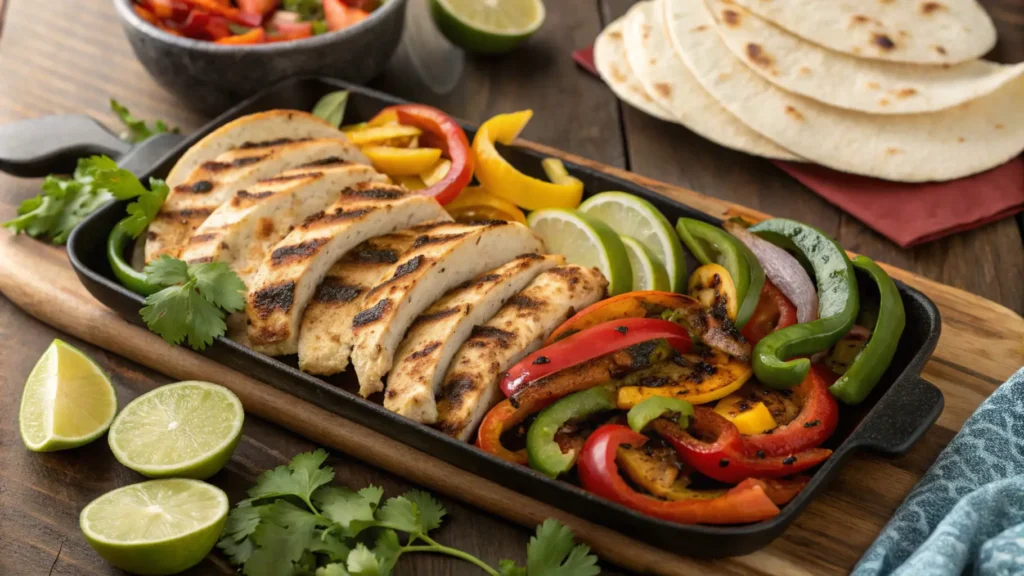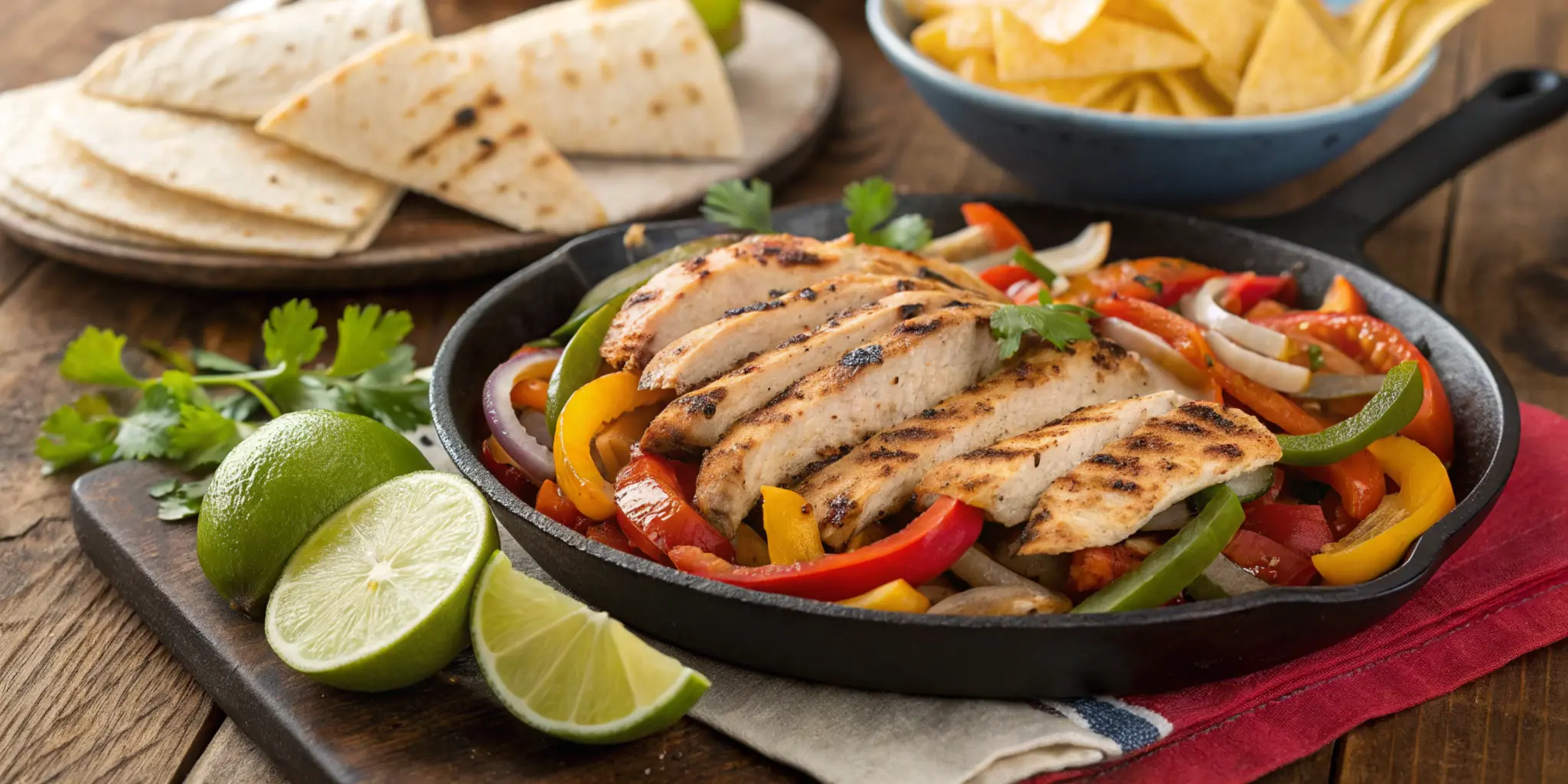Chicken fajitas are a crowd favorite, offering a burst of flavor, color, and aroma in every bite. But what sets apart a good fajita from a truly unforgettable one? The answer lies in the marinade. A well-crafted chicken fajita marinade transforms humble chicken into a flavorful and tender masterpiece. This article will take you step by step through the process, from understanding how marinades work to preparing, cooking, and serving a fajita feast that everyone will love.
What Makes a Perfect Chicken Fajita Marinade?
When it comes to fajitas, the marinade does the heavy lifting. It doesn’t just coat the chicken with spices; it infuses every bite with zesty lime, rich spices, and a touch of sweetness. A good marinade achieves three key things:
- It adds flavor.
- It tenderizes the meat.
- It keeps the chicken juicy during cooking.
To strike the right balance, you need a mixture of acid (like lime juice), fat (olive oil), and seasonings. Skip one of these components, and the results might fall short. But don’t fret; it’s simpler than it sounds when you know the basics.
The Science Behind Marinades: How They Work
Ever wondered how marinades work their magic? Acids, such as citrus juice or vinegar, break down the surface proteins in chicken, making the meat more tender and juicy. Oils act as flavor carriers, helping spices penetrate deeper into the meat. Then, spices like chili powder and garlic don’t just sit on top—they work their way in, creating layers of flavor that complement every bite.
It’s a chemistry lesson you can taste. However, there’s a fine line—too much acid can leave your chicken mushy, while the wrong oil can make it greasy. Stick with fresh ingredients and balanced proportions for a marinade that’s just right.
Essential Ingredients for a Flavorful Chicken Fajita Marinade
What goes into the perfect chicken fajita marinade? Let’s break it down:
- Acids: Lime juice, vinegar, or even pineapple juice for a tropical twist.
- Oils: Olive oil for richness, or avocado oil for a lighter touch.
- Seasonings: Chili powder, cumin, garlic powder, paprika, and black pepper are non-negotiables.
- Sweeteners: A drizzle of honey or a sprinkle of brown sugar adds a touch of sweetness to balance the heat.
| Ingredient | Purpose | Quantity (per pound of chicken) |
|---|---|---|
| Lime Juice | Adds acidity for tenderizing and tanginess | 2–3 tablespoons |
| Olive Oil | Locks in moisture and carries flavor | 3 tablespoons |
| Garlic (minced) | Boosts savory, aromatic flavor | 3–4 cloves |
| Chili Powder | Adds smoky, spicy notes | 1 teaspoon |
| Cumin | Provides earthy, warm spice | 1 teaspoon |
| Smoked Paprika | Enhances smoky depth | 1 teaspoon |
| Salt | Brings out natural flavors | ½ teaspoon |
| Black Pepper | Adds mild heat and balance | ½ teaspoon |
| Honey or Brown Sugar | Balances acidity and promotes caramelization | 1 teaspoon |
Optional ingredients like soy sauce or Worcestershire sauce can add depth, while fresh herbs such as cilantro give it a vibrant finish. Mix and match to suit your taste buds, but always aim for balance.

Step-by-Step Guide: Preparing and Marinating Chicken
Making a fantastic chicken fajita marinade doesn’t require years of culinary expertise—just a bit of patience and a few key techniques. Follow these steps to ensure your chicken turns out flavorful, tender, and downright irresistible.
Selecting the Right Cut of Chicken
Not all chicken cuts are created equal, especially when it comes to fajitas. Here’s how to choose:
- Chicken breasts: Lean, easy to slice, and great for those who prefer a milder flavor. However, they can dry out quickly, so marinating is a must.
- Chicken thighs: Juicier and more forgiving, thighs are perfect if you want bolder flavor and slightly more fat content.
- Chicken tenders: The quickest option to cook and serve. These are ideal for weeknights or small servings.
Whichever cut you pick, aim for uniform thickness. If the pieces vary too much, consider pounding them lightly with a meat mallet to even things out for more consistent cooking.

Mixing and Combining Ingredients in the Correct Order
Creating the marinade is like composing a symphony—each ingredient plays its part to perfection:
- Start with the acid: Add lime juice or vinegar to a mixing bowl first. This ensures the acidity evenly coats the chicken later.
- Follow with oil: Whisk in olive oil or your chosen alternative. This helps distribute the spices and keeps the chicken juicy.
- Add the dry spices: Stir in chili powder, cumin, paprika, garlic powder, and any additional seasonings. Adding these last prevents clumping and ensures an even mix.
- Sweeten the deal: If using honey or brown sugar, fold it in gently at the end. This step balances the tanginess and heat while also promoting caramelization during cooking.
Proper Techniques for Coating Chicken Evenly
Now comes the fun part: marinating!
- Place your chicken in a large zip-top bag, shallow dish, or glass bowl. Avoid metal containers as they can react with the acidic ingredients.
- Pour the marinade over the chicken, making sure each piece is fully submerged or well-coated.
- If using a bag, seal it tightly and gently massage the chicken to distribute the marinade evenly. This step also helps the flavors seep into every nook and cranny.
Pro Tip: Let the chicken rest in the marinade for at least 30 minutes to an hour, or up to 8 hours for maximum flavor. Anything longer could break down the texture too much, leaving the chicken mushy instead of tender.
Timing Matters: How Long to Marinate Chicken for Optimal Flavor
Marinating chicken might seem straightforward—just soak it and cook, right? Well, there’s more to it than meets the eye. Timing plays a crucial role in getting the flavors of the chicken fajita marinade to shine while keeping the chicken tender and juicy.
Recommended Marinating Times for Maximum Flavor Absorption
The amount of time your chicken spends soaking in the marinade affects how much flavor it absorbs. Here’s a general guide:
- Quick marinade: If you’re short on time, 30 minutes at room temperature can impart noticeable flavor. It’s perfect for a last-minute fajita craving.
- Ideal marination: For the best results, let the chicken rest in the marinade for 4–6 hours in the fridge. This gives the acids, oils, and spices enough time to penetrate the meat without overdoing it.
- Overnight soak: You can marinate the chicken for up to 8 hours, but anything beyond that is risky (more on this below).
If you’re marinating smaller cuts, like tenders, aim for the shorter end of the timeline. For thicker cuts, like whole breasts or thighs, give them closer to 6 hours for full flavor.
Risks of Over-Marinating (Texture and Taste Impact)
While longer marination times might seem like a good idea, there’s a catch. Over-marinating chicken can backfire in two ways:
- Texture problems: Acids in the marinade (like lime juice or vinegar) break down proteins to make chicken tender. However, too much acid for too long turns the meat mushy instead of juicy.
- Flavor imbalances: Over time, the marinade’s strong flavors can overwhelm the natural taste of the chicken, leaving it overly tangy or bitter.
To avoid these pitfalls, always stick to the recommended times and refrigerate the chicken while it marinates. Room-temperature marination for extended periods can lead to food safety risks, so don’t leave it out too long.
Cooking Methods for Marinated Chicken: Grilled, Pan-Seared, or Oven-Baked Fajitas
Once your chicken fajita marinade or lime and garlic chicken marinade has worked its magic, it’s time to cook the chicken to perfection. Should you grill it, sear it in a pan, or bake it in the oven? Each method brings unique textures and flavors, depending on the tools you have and your desired level of char or tenderness. Let’s break down the best cooking techniques for your marinated chicken.

Grilling Marinated Chicken: The Smoky, Bold Choice
Grilling is a classic way to cook grilled chicken fajita marinade, adding a smoky flavor that perfectly complements the spices and zest. If you love charred edges and caramelized flavors, this method is your go-to.
Tips for Success When Grilling Lime and Garlic Chicken
- Preheat your grill to medium-high heat and lightly oil the grates to prevent sticking.
- Shake off excess spicy fajita marinade from the chicken to avoid flare-ups caused by dripping.
Time and Temperature for Grilled Chicken Fajitas
Cook chicken breasts or thighs for approximately 6–8 minutes per side, making sure they reach an internal temperature of 165°F (74°C). To avoid undercooking or drying out the meat, always rely on a meat thermometer for accuracy.
The sugars in your Mexican chicken marinade will caramelize perfectly during grilling, forming a crispy and flavorful crust that enhances every bite. For the best results, serve your grilled fajitas hot off the grill, or let the chicken rest briefly to lock in the juices and keep the meat tender.
Pan-Searing Chicken in a Spicy Fajita Marinade
When grilling isn’t an option, pan-searing is a quick and flavorful alternative. It locks in the bold flavors of your easy fajita seasoning marinade and gives the chicken a golden, crispy edge.
Tips for Pan-Seared Chicken
- Heat a heavy skillet, like cast iron, over medium-high heat and add a small amount of oil.
- Avoid overcrowding the pan by cooking chicken pieces in batches for even browning.
Time and Temperature for Pan-Seared Fajitas
Sear each side for 4–5 minutes, then lower the heat and cook until the chicken reaches an internal temperature of 165°F.
Pan-searing creates a crispy exterior while keeping the marinade’s flavors locked inside, making it perfect for fajitas served with warm tortillas and fresh toppings.
Oven-Baking Marinated Chicken: The Easy, Consistent Method
If you prefer a hands-off approach, oven-baking is the ideal method for cooking chicken fajita marinade. It’s especially great for larger batches or thicker cuts of chicken.
Tips for Baking Marinated Chicken
- Preheat the oven to 400°F (200°C), and line a baking sheet with foil or parchment paper for easy cleanup.
- Arrange the chicken in a single layer to ensure even cooking.
Time and Temperature for Oven-Baked Fajitas
Bake for 20–25 minutes, flipping halfway through, until the chicken reaches an internal temperature of 165°F. For an added smoky flavor, broil the chicken for the last 2–3 minutes to achieve a light char.
No matter which method you choose, let the chicken rest for at least 5 minutes before slicing. This allows the juices to redistribute, ensuring every bite is tender and flavorful.tes before slicing. This locks in the juices and ensures every bite is succulent.
Troubleshooting Common Marinade Mistakes for Chicken Fajitas
Even the best chicken fajita marinade recipes—whether it’s a spicy fajita marinade or a lime and garlic chicken marinade—can hit a snag if a few key details go awry. Overpowering flavors, too much acid, or issues like sticking and burning during cooking are common hiccups. But don’t worry; these problems are easy to solve with the right approach.
Fixing Overpowering Flavors in a Lime and Garlic Chicken Marinade
Sometimes, marinades like Mexican chicken marinade can dominate the natural flavor of the chicken. To strike the right balance:
- Balance is key: If your grilled chicken fajita marinade tastes overly tangy or bitter, add a touch of sweetness like honey or brown sugar to mellow out the acidity. Sweeteners work wonders in counteracting sharp flavors.
- Watch the acid ratio: Using too much lime juice or vinegar can leave your chicken mushy. Stick to 1–2 tablespoons of acid per pound of chicken and limit marination to a maximum of 8 hours.
- Rinse lightly if needed: If the chicken has over-marinated, rinsing it briefly under cold water can remove excess marinade. Pat it dry before cooking to avoid excess moisture affecting the texture.
Preventing Sticky or Burnt Marinades in a Spicy Fajita Marinade
When cooking marinated chicken, sticky or burnt residues can ruin the presentation and flavor. Here’s how to prevent that:
- Shake off the excess: Before placing your chicken on the grill or pan, let any extra easy fajita seasoning marinade drip off. Sugars in the marinade can burn quickly, so less is more.
- Oil the surface: Whether using a grill, skillet, or oven, apply a thin layer of oil to the cooking surface to minimize sticking.
- Monitor the heat: Cook at medium-high heat for the perfect caramelization without burning. If your marinade includes high-sugar ingredients like honey, reduce the heat slightly to prevent scorching.
By following these tips, your chicken fajita marinade will deliver bold flavors without any mishaps, ensuring your fajitas are as tasty as they are picture-perfect!
Chicken Fajita Marinade for Meal Prep: Storing and Freezing Tips
Preparing chicken fajita marinade ahead of time is a lifesaver for busy weeks. Whether you’re refrigerating for tomorrow’s dinner or freezing for future meals, using the right techniques ensures your grilled chicken fajita marinade keeps the chicken flavorful, tender, and safe to eat. Let’s explore the best methods for handling your Mexican chicken marinade to make meal prep effortless and delicious.
Proper Methods for Refrigerating Marinated Chicken
If you’re planning to use your lime and garlic chicken marinade within a day or two, refrigeration is the best option:
- Storage duration: Marinated chicken can be kept safely in the fridge for up to 24–48 hours. Beyond that, the acids in the marinade (such as lime juice or vinegar) can start to break down the chicken’s texture, making it too soft or mushy.
- How to store: Place the chicken and spicy fajita marinade in a resealable zip-top bag or shallow glass container with a tight-fitting lid. Resealable bags are ideal for ensuring the marinade thoroughly coats every piece while saving space in the fridge.
- Prevent contamination: Always store marinated chicken on the bottom shelf of the fridge to prevent juices from dripping onto other foods.
Freezing Marinated Chicken for Long-Term Storage
Freezing chicken in its easy fajita seasoning is an excellent option for long-term meal prep, locking in its bold, zesty flavors:
- Before freezing: Transfer the chicken and Mexican chicken marinade to a freezer-safe bag or container. Press out as much air as possible to minimize freezer burn.
- Freezer shelf life: Frozen marinated chicken stays fresh for up to 3 months. Be sure to label the bag with the date so you can keep track of how long it’s been stored.
- Thawing tips: When ready to cook, thaw the marinated chicken overnight in the refrigerator. Avoid leaving it out at room temperature, as this can lead to harmful bacteria growth.
Best Containers for Storing Your Marinated Chicken
Choosing the right container is crucial to keeping your lime and garlic chicken marinade fresh and your chicken well-coated:
- Zip-top freezer bags: These are perfect for even coating and space-saving in both the fridge and freezer.
- Glass containers: Eco-friendly and safe, glass prevents any unwanted flavor or chemical transfer, which can occur with certain plastics.
- Vacuum-sealed bags: If you want to extend the shelf life of your frozen chicken, vacuum-sealed bags are a fantastic option. They reduce air exposure and freezer burn significantly.
By mastering these storage tips, your grilled chicken fajita marinade will always be ready to deliver bold, flavorful meals on demand!
Versatile Marinades: Adapting the Recipe for Beef, Shrimp, and Veggies
The beauty of a great chicken fajita marinade lies in its incredible adaptability. In fact, with just a few simple tweaks, you can easily use the same recipe to transform beef, shrimp, or even vegetables into deliciously flavorful fajita favorites. Additionally, each ingredient absorbs the bold spices and tangy zest in its own unique way, bringing a fresh twist to fajitas every single time.
Ingredient Adjustments for Different Proteins or Vegetarian Options
A one-size-fits-all approach doesn’t always work when switching proteins or preparing veggies, but slight adjustments ensure the perfect flavor profile:
- For beef fajitas: Use cuts like skirt steak, flank steak, or sirloin. Add a splash of soy sauce or Worcestershire sauce to complement the beef’s robust flavor. Skip any added sugar, as beef doesn’t need the extra sweetness.
- For shrimp fajitas: Shrimp requires a shorter marination time (more on that below), so keep the marinade lighter. Reduce the lime juice slightly to prevent overpowering the delicate shrimp flavor.
- For veggies: Sturdy vegetables like bell peppers, zucchini, mushrooms, or red onions absorb flavor beautifully. Add a tablespoon of balsamic vinegar or a dash of smoked paprika for depth.
Don’t hesitate to experiment with alternative ingredients, like tofu or portobello mushrooms, for a vegetarian-friendly version.
Cooking Time Variations Based on Protein Type
Cooking times are key to ensuring each protein or vegetable is tender without losing its natural texture:
- Beef: Grill or pan-sear beef slices for 2–4 minutes per side on high heat, or until cooked to your preferred level of doneness.
- Shrimp: Shrimp cook quickly—just 1–2 minutes per side on a hot grill or skillet is all you need. Their texture should turn firm, with a pink hue.
- Veggies: Roast vegetables in the oven at 400°F (200°C) for 15–20 minutes, flipping halfway. Or grill them for 5–8 minutes until they’re slightly charred but still tender.
By customizing the marinade and cooking times, you can bring out the best in any protein or vegetable. Whether you’re catering to meat lovers or vegetarians, these versatile fajitas are sure to be a hit!
What to Serve with Chicken Fajitas: Pairing Ideas
A plate of sizzling chicken fajitas is already a feast for the senses, but pairing it with the right sides and accompaniments can take your meal to the next level. From hearty sides to flavorful toppings, every addition enhances the experience. Here’s how to round out your fajita feast with ease.
Side Dishes: Rice, Beans, Guacamole, or Tortillas
No fajita meal is complete without a few classic sides to complement the bold, zesty flavors of your chicken fajita marinade. Here are some tried-and-true favorites:
- Mexican rice: Fluffy rice cooked with tomatoes, garlic, and spices adds a comforting, carb-rich balance to the dish.
- Refried beans or black beans: Creamy refried beans or a lightly seasoned black bean salad provide extra protein and a satisfying texture.
- Guacamole: Fresh guacamole, with its creamy avocado and tangy lime, makes the perfect topping or dip for fajitas.
- Tortillas: Soft, warm tortillas are a must. Whether you prefer flour or corn, tortillas are essential for wrapping up the juicy chicken, sautéed veggies, and toppings in every bite.
For added variety, include a fresh side salad with a citrus vinaigrette, or even a scoop of tangy coleslaw to bring some crunch.
Beverage Pairings: Non-Alcoholic Alternatives
While classic margaritas might come to mind, there are plenty of refreshing non-alcoholic options that pair wonderfully with chicken fajitas:
- Citrus spritzers: Sparkling water with a splash of lime or orange juice is a crisp, fizzy option.
- Horchata: This sweet, cinnamon-infused rice milk drink adds a smooth, cool contrast to the fajitas’ heat.
- Agua fresca: Light and fruity, drinks like watermelon or cucumber agua fresca cleanse the palate while keeping things fresh.
These pairings add variety and flavor to your fajita meal, creating a spread that’s as satisfying as it is delicious!
Healthier Alternatives: Making a Low-Calorie Chicken Fajita Marinade
Looking for ways to savor the bold flavors of chicken fajitas without packing in extra calories? A few simple swaps can turn your spicy fajita marinade into a lighter, healthier option that still delivers big on taste. With these tips, you’ll enjoy guilt-free fajitas without compromising on flavor or texture.
Using Low-Fat or Alternative Ingredients
Swapping out high-fat or sugary components in your Mexican chicken marinade is easier than you might think:
- Greek yogurt: Replace traditional oil with plain, low-fat Greek yogurt. It not only tenderizes the chicken naturally but also adds creaminess and a dose of protein.
- Apple cider vinegar: Use apple cider vinegar instead of lime juice or standard vinegar. Slightly sweeter and lower in calories, it’s a flavorful alternative with added health perks.
- Fresh herbs and spices: Ditch store-bought fajita mixes, which are often loaded with sodium. Instead, use fresh garlic, chopped cilantro, chili powder, cumin, and smoked paprika for a fresher, more vibrant marinade.
These swaps keep your lime and garlic chicken marinade flavorful and nutrient-rich while cutting unnecessary fats and processed ingredients.For more information on the health advantages of these ingredients, visit Healthline.
Reducing Sugar and Oil Content Without Compromising Flavor
While oil and sugar add richness to most marinades, you can easily reduce their amounts without sacrificing taste:
- Cut the oil: Stick to just 1 tablespoon of olive oil, or eliminate it altogether by substituting with vegetable broth or a splash of orange juice.
- Replace sugar with natural sweeteners: Use a teaspoon of honey or pure maple syrup to replace brown sugar. Or, skip sweeteners entirely and let the natural sugars in bell peppers or onions shine through.
- Enhance with zest: Adding lime or orange zest amplifies tangy, citrusy flavors without adding calories.
By focusing on fresh ingredients and smart substitutions, your grilled chicken fajita marinade will stay flavorful, satisfying, and low-calorie. These tweaks let you enjoy your favorite fajitas while keeping things light, nutritious, and incredibly tasty!
Frequently Asked Questions
How long should I marinate chicken for fajitas?
For optimal flavor, marinate chicken for 4–6 hours in the refrigerator. If you’re short on time, a quick 30-minute marinade at room temperature works too. Avoid marinating for more than 8 hours, as it can affect the chicken’s texture.
How to make chicken fajita marinade?
To make a delicious chicken fajita marinade, mix lime juice, olive oil, garlic, chili powder, cumin, paprika, and a touch of honey or brown sugar. Whisk until combined, then pour over chicken and let it rest in the fridge before cooking.
For an easy, step-by-step approach to crafting a mouthwatering marinade, don’t miss our How to Make the Best Chicken Fajita Marinade: Easy Step-by-Step Guide.
What is a good marinade for chicken fajitas?
A great marinade combines acidity (lime juice), oil (olive or avocado), and bold spices like cumin, chili powder, garlic, and paprika. Adding a little sweetness, like honey or orange juice, balances the flavors beautifully.
To discover what makes a truly great marinade for chicken fajitas, check out our What Is a Good Marinade for Chicken Fajitas? Ultimate Guide.
What is fajita marinade made of chicken?
A typical fajita marinade includes lime juice, olive oil, minced garlic, chili powder, cumin, smoked paprika, salt, and black pepper. For an extra layer of depth, you can also incorporate ingredients such as fresh cilantro, soy sauce, or Worcestershire sauce to enhance the flavor profile.
For a complete breakdown of what goes into a chicken fajita marinade, visit our What Is Fajita Marinade Made of for Chicken? Complete Guide.
What is chicken fajita seasoning made of?
Chicken fajita seasoning includes a blend of chili powder, cumin, paprika, garlic powder, onion powder, oregano, salt, and black pepper. It’s easy to make at home and adds bold flavor to marinades or directly to chicken.
Want to learn more about the core spices and how they contribute to the flavor profile? Check out our What is Chicken Fajita Seasoning Made Of? A Complete Guide to Ingredients and Variations.
Can you marinate fajitas too long?
Yes, over-marinating can make the chicken mushy due to the acidic components like lime juice or vinegar. To avoid this, stick to the recommended 4–6 hours for marination.
What is the formula for chicken marinade?
The basic formula is 3 parts oil, 1 part acid, and 1 part flavorings (spices, herbs, and sweeteners). For example, use 3 tablespoons of olive oil, 1 tablespoon of lime juice, and 1 tablespoon of your preferred spices or seasonings. Adjust quantities to taste!
Conclusion
Crafting the perfect chicken fajita marinade doesn’t have to be complicated. In fact, with the right balance of acidity, oils, spices, and just a touch of sweetness, you can easily create a flavorful, tender, and juicy chicken that’s absolutely perfect for fajitas. Moreover, from selecting the ideal cut of chicken to customizing the marinade for beef, shrimp, or veggies, the possibilities truly are endless.
Remember, timing is key—marinate your chicken long enough to infuse it with flavor; however, avoid leaving it too long, as this can negatively affect its texture. Furthermore, whether you choose to grill, pan-sear, or bake, this chicken fajita marinade will undeniably elevate your fajitas into a meal that feels as though it came straight from a restaurant.
Pair it with classic sides like guacamole and rice, or opt for healthier twists like low-fat yogurt-based marinades to suit your lifestyle.
With these tips and techniques, you’re all set to serve a delicious fajita feast that’s sure to impress your family and friends. So grab your ingredients, whip up your marinade, and get ready to enjoy fajitas that burst with bold, zesty flavors in every bite!

